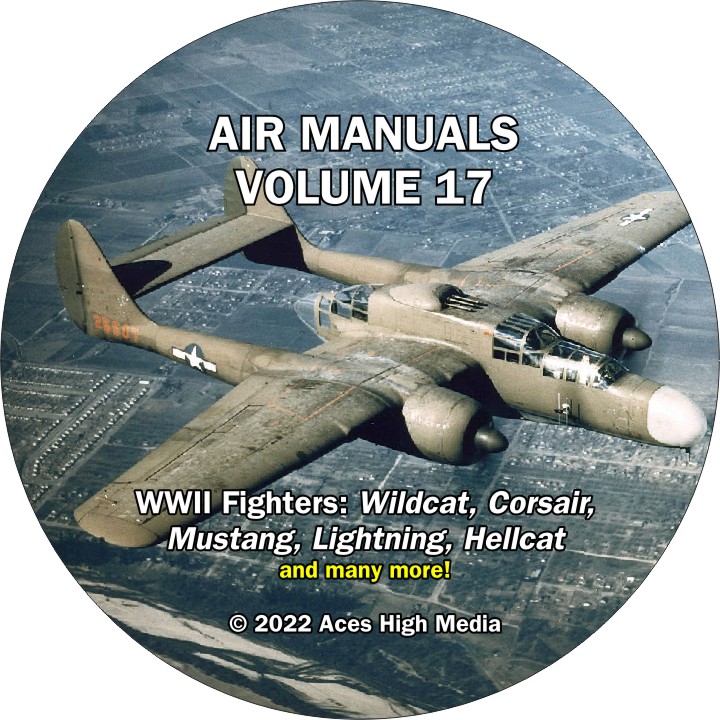Aces High Air Manuals
Volume 17: WWII Fighters & Fighter/Bombers
F2A Buffalo

|
Brewster F2A Buffalo Pilot's Notes
27 pages
The Brewster F2A Buffalo was an American fighter aircraft which saw service early in World War II. Designed and built by the Brewster Aeronautical Corporation, it was one of the first U.S. monoplanes with an arrestor hook and other modifications for aircraft carriers. The Buffalo won a competition against the Grumman F4F Wildcat in 1939 to become the U.S. Navy's first monoplane fighter aircraft. Although superior to the Grumman F3F biplane it replaced and the early F4Fs, the Buffalo was largely obsolete when the United States entered World War 2 being unstable and overweight, especially when compared to the Japanese Mitsubishi A6M Zero.
|
F4F/FM-2 Wildcat
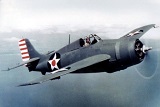
|
General Motors FM-2 (British model Wildcat VI) Pilot's Handbook of Flight Operating Instructions, 14 June 1945
75 pages
The Grumman F4F Wildcat was an American carrier-based fighter aircraft that began service with both the United States Navy and the British Royal Navy (as the Martlet) in 1940. First used in combat by the British in Europe, the Wildcat was the only effective fighter available to the United States Navy and Marine Corps in the Pacific Theater during the early part of World War II in 1941 and 1942; the disappointing Brewster Buffalo was withdrawn in favor of the Wildcat and replaced as units became available. With a top speed of 318 mph (512 km/h), the Wildcat was outperformed by the faster 331 mph (533 km/h), more maneuverable, and longer ranged Mitsubishi A6M Zero. However, the F4F's ruggedness, coupled with tactics such as the Thach Weave, resulted in an air combat kill-to-loss ratio of 5.9:1 in 1942 and 6.9:1 for the entire war.
After Grumman ceased production of the F4F in 1943, General Motors/Eastern Aircraft continued production, building 5,280 FM variants of the Wildcat, which were designated FM-1 and FM-2. The FM-2 is the variant covered in this document. |
F4U Corsair
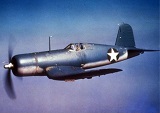
|
Vought F4U Corsair Pilot's Handbook
70 pages
The Vought F4U Corsair is an American fighter aircraft that saw service primarily in World War II and the Korean War. Demand for the aircraft soon overwhelmed Vought's manufacturing capability, resulting in production by Goodyear and Brewster: Goodyear-built Corsairs were designated FG and Brewster-built aircraft F3A. From the first prototype delivery to the U.S. Navy in 1940, to final delivery in 1953 to the French, 12,571 F4U Corsairs were manufactured, in 16 separate models, in the longest production run of any piston-engined fighter in U.S. history (1942–53).
The Corsair was designed as a carrier-based aircraft but its difficult carrier landing performance rendered it unsuitable for Navy use until the carrier landing issues were overcome by the British Fleet Air Arm. The Corsair thus came to and retained prominence in its area of greatest deployment: land based use by the U.S. Marines. The role of the dominant U.S. carrier based fighter in the second part of the war was thus filled by the Grumman F6F Hellcat, powered by the same Double Wasp engine first flown on the Corsair's first prototype in 1940. The Corsair served to a lesser degree in the U.S. Navy. As well as the U.S. and British use the Corsair was also used by the Royal New Zealand Air Force, the French Navy Aéronavale and other, smaller, air forces until the 1960s. Some Japanese pilots regarded it as the most formidable American fighter of World War II, and the U.S. Navy counted an 11:1 kill ratio with the F4U Corsair. After the carrier landing issues had been tackled, it quickly became the most capable carrier-based fighter-bomber of World War II. The Corsair served almost exclusively as a fighter-bomber throughout the Korean War and during the French colonial wars in Indochina and Algeria. |
F6F Hellcat
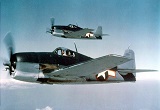
|
Grumman F6F Hellcat Flight Manual
57 pages
The Grumman F6F Hellcat was an American carrier-based fighter aircraft designed to replace the earlier F4F Wildcat in United States Navy (USN) service. The Hellcat competed with the faster Vought F4U Corsair for use as a carrier based fighter. The Corsair had significant issues with carrier landings which the Hellcat did not, allowing the Hellcat to become the Navy's dominant fighter in the second part of World War II, a position the Hellcat did not relinquish. The Corsair instead was primarily deployed to great effect in land-based use by the U.S. Marine Corps.
Although the F6F resembled the Wildcat in some ways, it was a new design, powered by a 2,000 hp Pratt & Whitney R-2800, the same powerplant used for both the Corsair and the United States Army Air Force (USAAF) Republic P-47 Thunderbolt fighters. Some military observers tagged the Hellcat as the "Wildcat's big brother". The F6F was best known for its role as a rugged, well-designed carrier fighter which was able, after its combat debut in early 1943, to counter the Mitsubishi A6M Zero and help secure air superiority over the Pacific Theater. Such was the quality of the basic simple, straightforward design, that 12,200 were built in just over two years. Hellcats were credited with destroying a total of 5,223 enemy aircraft while in service with the U.S. Navy, U.S. Marine Corps and the Royal Navy Fleet Air Arm. This was more than any other Allied naval aircraft. Postwar, the Hellcat was phased out of front line service but remained in service as late as 1954 as a night fighter. |
F7F Tigercat
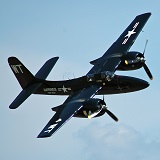
|
Grumman F7F Tigercat Pilot's Handbook
121 pages
The Grumman F7F Tigercat is a heavy fighter aircraft that served with the United States Navy (USN) and United States Marine Corps (USMC) from late in World War II until 1954. It was the first twin-engined fighter to be deployed by the USN. While the Tigercat was delivered too late to see combat in World War II, it saw action as a night fighter and attack aircraft during the Korean War.
Designed initially for service on Midway-class aircraft carriers, early production F7Fs were land-based variants. The type was too large to operate from older and smaller carriers, and only a late variant (F7F-4N) was certified for carrier service. |
F8F Bearcat

|
Grumman F8F Bearcat Pilot's Handbook
113 pages
The Grumman F8F Bearcat was a single-engine American fighter aircraft introduced in late World War II. It went on to serve into the mid-20th century in the United States Navy, the United States Marine Corps, and the air forces of other nations. It would be Grumman Aircraft's final piston engined fighter aircraft. Modified versions have broken speed records for piston-engined aircraft, and are popular among warbird owners.
Photo credit: Chowells@wikipedia License: CC-BY-SA 3.0 |
P-36 Hawk

|
Curtiss P-36A and P-36C Hawk Handbook of Operation and Flight Instructions
11 pages
The Curtiss P-36 Hawk, also known as the Curtiss Hawk Model 75, was an American-designed and built fighter aircraft of the 1930s and 40s. A contemporary of both the Hawker Hurricane and Messerschmitt Bf 109, it was one of the first of a new generation of combat aircraft—a sleek monoplane design making extensive use of metal in its construction and powered by a powerful radial engine.
Perhaps best known as the predecessor of the Curtiss P-40 Warhawk, the P-36 saw little combat with the United States Army Air Forces during World War II. It was nevertheless the fighter used most extensively and successfully by the French Armee de l'air during the Battle of France. The P-36 was also ordered by the governments of the Netherlands and Norway, but did not arrive in time to see action over either country, before both were occupied by Nazi Germany. The type was also manufactured under license in China, for the Republic of China Air Force, as well as in British India, for the Royal Air Force (RAF) and Royal Indian Air Force (RIAF). |

|
Curtiss P-36 Hawk Model 75-A Detail Specifications
14 pages
Axis and co-belligerent air forces also made significant use of captured P-36s. Following the fall of France and Norway in 1940, several dozen P-36s were seized by Germany and transferred to Finland; these aircraft saw extensive action with the Ilmavoimat (Air Force) against the Soviet Air Forces. The P-36 was also used by Vichy French air forces in several minor conflicts; in one of these, the Franco-Thai War of 1940–41, P-36s were used by both sides.
|
P-38 Lightning

|
Lockheed P-38 Lightning Flight Manual
109 pages
The Lockheed P-38 Lightning was a World War II fighter aircraft. Developed to a United States Army Air Corps requirement, the P-38 had distinctive twin booms and a single, central nacelle containing the cockpit and armament. Named "fork-tailed devil" by the Luftwaffe and "two planes, one pilot" by the Japanese, the P-38 was used in a number of roles, including dive bombing, level bombing, ground-attack, night fighting, photo reconnaissance missions, and extensively as a long-range escort fighter when equipped with drop tanks under its wings.
The P-38 was used most successfully in the Pacific Theater of Operations and the China-Burma-India Theater of Operations as the mount of America's top aces, Richard Bong (40 victories) and Thomas McGuire (38 victories). In the South West Pacific theater, the P-38 was the primary long-range fighter of United States Army Air Forces until the appearance of large numbers of P-51D Mustangs toward the end of the war. The P-38 was unusually quiet for a fighter, the exhaust muffled by the turbo-superchargers. It was extremely forgiving, and could be mishandled in many ways, but the rate of roll in the early versions was too slow for it to excel as a dogfighter. The P-38 was the only American fighter aircraft in production throughout American involvement in the war, from Pearl Harbor to Victory over Japan Day. |
P-39 Airacobra

|
Bell P-39 Airacobra Flight Manual
24 pages
The Bell P-39 Airacobra was one of the principal American fighter aircraft in service when the United States entered World War II. The P-39 was used with great success by the Soviet Air Force, which scored the highest number of individual kills attributed to any U.S. fighter type. Other major users of the type included the Free French, the Royal Air Force, the United States Army Air Forces, and the Italian Co-Belligerent Air Force. Designed by Bell Aircraft, it had an innovative layout, with the engine installed in the center fuselage, behind the pilot, and driving a tractor propeller via a long shaft. It was also the first fighter fitted with a tricycle undercarriage. Although its mid-engine placement was innovative, the P-39 design was handicapped by the absence of an efficient turbo-supercharger, limiting it to low-altitude work. Together with the derivative P-63 Kingcobra, the P-39 was one of the most successful fixed-wing aircraft manufactured by Bell. |
P-40 Warhawk

|
Curtiss P-40 Warhawk Pilot Training Manual
94 pages
The Curtiss P-40 Warhawk was a single-engined, single-seat, all-metal fighter and ground-attack aircraft that first flew in 1938. The P-40 design was a modification of the previous Curtiss P-36 Hawk which reduced development time and enabled a rapid entry into production and operational service. The Warhawk was used by most Allied powers during World War II, and remained in frontline service until the end of the war. It was the third most-produced American fighter, after the P-51 and P-47; by November 1944, when production of the P-40 ceased, 13,738 had been built.
|

|
Curtiss P-40 Warhawk Manual
21 pages
Additional detail for the Curtiss P-40 Warhawk.
|
P-43 Lancer

|
Republic P-43, P-43A, and YP-43 Lancer Handbook of Operation and Flight Instructions
32 pages
The Republic P-43 Lancer was a single-engine, all-metal, low-wing monoplane fighter aircraft built by Republic, first delivered to the United States Army Air Corps in 1940. While no world-beater as a fighter, the P-43A had a very good high-altitude performance coupled with an effective oxygen system. Until the arrival of the Lockheed P-38 Lightning, the Lancer was the only American fighter capable of catching a Japanese Mitsubishi Ki-46 Dinah reconnaissance plane at the speeds and heights at which they flew.
|
P-47 Thunderbolt

|
Republic P-47B/C/D/G Thunderbolt Flight Manual
54 pages
The Republic P-47 Thunderbolt was a World War II era fighter aircraft produced by the United States between 1941–1945. Its primary armament was eight .50-caliber machine guns, four per wing, and in the fighter-bomber ground-attack role it could carry five-inch rockets or a bomb load of 2,500 pounds, more than half the payload of the Boeing B-17 Flying Fortress bomber. When fully loaded the P-47 weighed up to eight tons making it one of the heaviest fighters of the war. The P-47 was designed around the powerful Pratt & Whitney R-2800 Double Wasp engine which was the same engine also used by two very successful U.S. Navy fighters, the Grumman F6F Hellcat and the Vought F4U Corsair. The Thunderbolt was very effective as a short-to-medium range escort fighter in high-altitude air-to-air combat but was also adept at ground attack in both the World War II European and Pacific Theaters.
The P-47 was one of the main United States Army Air Forces (USAAF) fighters of World War II, and served with other Allied air forces, notably those of France, Britain, and Russia. Mexican and Brazilian squadrons fighting alongside the U.S. were equipped with the P-47. The armored cockpit was roomy inside, comfortable for the pilot, and offered good visibility. A modern-day U.S. ground-attack aircraft, the Fairchild Republic A-10 Thunderbolt II, takes its name from the P-47. |
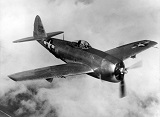
|
Republic P-47N Thunderbolt Flight Manual
111 pages
The P-47N was the last Thunderbolt variant to be produced. It was designed as an escort fighter for the Boeing B-29 Superfortress bombers flying raids on the Japanese home islands. Increased internal fuel capacity and drop tanks had done much to extend the Thunderbolt's range during its evolution, and the only other way to expand the fuel capacity was to put fuel tanks into the wings. Thus, a new wing was designed with two 50 U.S. gal fuel tanks. The second YP-47N with this wing flew in September 1944. The redesign proved successful in extending range to about 2,000 mi (3,200 km), and the squared-off wingtips improved the roll rate. The P-47N entered mass production with the uprated R-2800-77(C) engine, with a total of 1,816 built. The very last Thunderbolt to be built, a P-47N-25, rolled off the production line in October 1945.
|
P-51 Mustang

|
North American P-51D Mustang Flight Manual
127 pages
The North American Aviation P-51 Mustang was a long-range, single-seat fighter and fighter-bomber used during World War II, the Korean War and other conflicts. The Mustang was conceived, designed and built by North American Aviation (NAA) in response to a specification issued directly to NAA by the British Purchasing Commission.
At the start of the Korean War, the Mustang was the main fighter of the United Nations until jet fighters such as the F-86 took over this role; the Mustang then became a specialized fighter-bomber. Despite the advent of jet fighters, the Mustang remained in service with some air forces until the early 1980s. After World War II and the Korean War, many Mustangs were converted for civilian use, especially air racing, and increasingly, preserved and flown as historic warbird aircraft at airshows. |
We have more P-51 Manuals!
Many more flight manuals, SACs, and maintenance/parts manuals in depth for the North American P-51 Mustang can be found on Aces High Air Manuals disc #48, "P-51 Mustang In Depth"
P-61 Black Widow

|
Northrop P-61 Black Widow Flight Manual
123 pages
The Northrop P-61 Black Widow, named for the spider, was the first operational U.S. warplane designed as a night fighter, and the first aircraft designed to use radar. The P-61 had a crew of three: pilot, gunner, and radar operator. It was armed with four 20 mm (.79 in) Hispano M2 forward-firing cannons mounted in the lower fuselage, and four .50 in (12.7 mm) M2 Browning machine guns mounted in a remote-controlled dorsal gun turret.
|

|
Northrop Army Model P-61A Black Widow Pilot's Flight Operating Instructions
68 pages
The P-61 was an all-metal, twin-engine, twin-boom design developed during World War II. The first test flight was made on 26 May 1942, with the first production aircraft rolling off the assembly line in October 1943. The last aircraft was retired from government service in 1954.
Although not produced in the large numbers of its contemporaries, the Black Widow was effectively operated as a night-fighter by United States Army Air Forces squadrons in the European Theater, the Pacific Theater, the China Burma India Theater and the Mediterranean Theater during World War II. It replaced earlier British-designed night-fighter aircraft that had been updated to incorporate radar when it became available. After the war, the P-61 - redesignated the F-61 - served in the United States Air Force as a long-range, all weather, day/night interceptor for Air Defense Command until 1948, and Fifth Air Force until 1950. On the night of 14 August 1945, a P-61B of the 548th Night Fight Squadron named "Lady in the Dark" was unofficially credited with the last Allied air victory before V-J Day. The P-61 was also modified to create the F-15 Reporter photo-reconnaissance aircraft for the United States Army Air Forces and subsequently used by the United States Air Force. |
P-63 Kingcobra

|
Bell P-63 Kingcobra Flight Manual
20 pages
The Bell P-63 Kingcobra is an American fighter aircraft developed by Bell Aircraft in World War II from the Bell P-39 Airacobra in an attempt to correct that aircraft's deficiencies. Although the P-63 was not accepted for combat use by the United States Army Air Forces, it was successfully adopted by the Soviet Air Force.
|
YFM-1 Airacuda
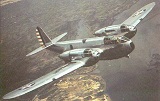
|
Bell YFM-1 Airacuda Handbook of Instructions for Operation and Flight
29 pages
The Bell YFM-1 Airacuda was an American heavy fighter aircraft, developed by the Bell Aircraft Corporation during the mid-1930s. It was the first military aircraft produced by Bell. Originally designated the "Bell Model 1," the Airacuda first flew on 1 September 1937. The Airacuda was marked by bold design advances and considerable flaws that eventually grounded the aircraft.
The Airacuda was Bell Aircraft's answer for a "bomber destroyer" aircraft. Although it did see limited production, and one fully operational squadron was eventually formed, only one prototype and 12 production models were ultimately built. |
A-33 (8A-5)

|
Douglas A-33 Model 8A-5 Pilot's Handbook
87 pages
The Douglas A-33 (Model 8A-5) was an updated version of the Northrop A-17 for the export market, with a more powerful engine and increased bomb load.
Early in 1940, the Norwegian government ordered 36 8A-5s which not had been delivered before Norway was invaded by the Germans. Completed between October 1940 and January 1941, the aircraft were delivered to a training center in Canada that had been set up for the Norwegian government-in-exile, named "Little Norway" at Toronto Island Airport, Ontario. After the loss of two aircraft and a reassessment of the training needs now met by the use of other aircraft, the remaining 34 Model 8A-5Ps were sold to Peru. However, 31 were repossessed by the Army Air Corps at the start of World War II. These aircraft, designated A-33, were used for training, target tug, and utility duties. |
A-31/A-35 Vengeance

|
Vultee A-35B-1-VN Vengeance (British Vengeance IV) Pilot's Flight Operating Instructions 1/3
35 pages
The Vultee A-31 Vengeance was an American dive bomber of World War II, built by Vultee Aircraft. This modified version was designated A-35.
|

|
Vultee A-35B-1-VN Vengeance (British Vengeance IV) Pilot's Flight Operating Instructions 2/3
35 pages
The Vengeance was not used operationally by the United States, but was operated as a front-line aircraft by the British Royal Air Force, the Royal Australian Air Force, and the Indian Air Force in Southeast Asia and the Southwest Pacific. The A-31 remained in service with U.S. units until 1945, primarily in a target-tug role.
|

|
Vultee A-35B-1-VN Vengeance (British Vengeance IV) Pilot's Flight Operating Instructions 3/3
27 pages
One complete Vengeance IA that did not see squadron service, serial number A27-99 (EZ999), is displayed at the Camden Museum of Aviation at Narellan, New South Wales, Australia.
|
BTD Destroyer
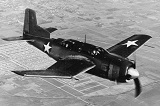
|
Douglas BTD-1 Destroyer Pilot's Handbook
114 pages
The Douglas BTD Destroyer was an American dive/torpedo bomber developed for the United States Navy during World War II. A small number had been delivered before the end of the war, but none saw combat.
|
SB2U Vindicator

|
Vought Sikorsky SB2U-3 Vindicator Pilot's Handbook
31 pages
The Vought SB2U Vindicator is an American carrier-based dive bomber developed for the United States Navy in the 1930s, the first monoplane in this role. Obsolete at the outbreak of World War II, Vindicators still remained in service at the time of the Battle of Midway, but by 1943, all had been withdrawn to training units. It was known as the Chesapeake in Royal Navy service.
|
SBD Dauntless
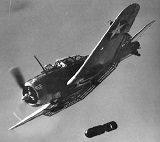
|
Douglas SBD-3 Dauntless Pilot's Handbook
103 pages
The Douglas SBD Dauntless is a World War II American naval scout plane and dive bomber that was manufactured by Douglas Aircraft from 1940 through 1944. The SBD ("Scout Bomber Douglas") was the United States Navy's main carrier-based scout/dive bomber from mid-1940 through mid-1944. The SBD was also flown by the United States Marine Corps, both from land air bases and aircraft carriers. The SBD is best remembered as the bomber that delivered the fatal blows to the Japanese carriers at the Battle of Midway in June 1942. The type earned its nickname "Slow But Deadly" (from its SBD initials) during this period. 5.936 SBDs were built, and the type was not retired until 1959.
|
